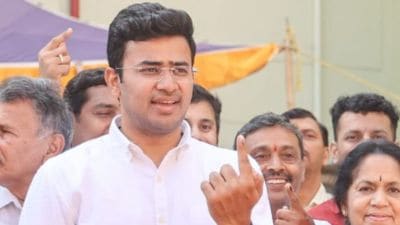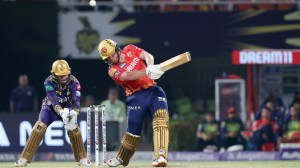- India
- International
Is there a vikas vote? Healthier babies make not a whimper on campaign pitch
The Indian Express travels to constituencies that have seen the sharpest improvement on various social indicators during the UPA years and finds out if that change is an election issue.
The Indian Express travels to constituencies that have seen the sharpest improvement on various social indicators during the UPA years and finds out if that change is an election issue. We begin with Hazaribagh
Jharkhand is a state identified with its mafia, Maoists and mortality. But recent data suggests the last “m” is changing. Many districts are seeing sudden improvements in their infant mortality rate. One of these is Hazaribagh, where a royal is doing battle on Thursday with a political princeling.
Of every 1,000 children born, 29 under the age of one die every year in Hazaribagh, according to the latest results of the Annual Health Survey of the Indian census organisation. While high, this figure marks a whopping 22 per cent decrease in the infant mortality rate for the preceding three years, making it the district with the second highest decline among 304 backward districts. Many other Jharkhand districts are doing well, and the state has the lowest IMR among the nine surveyed.
The main cause of this improvement is a fourth “m” pouring into Jharkhand: money. Chief secretary R S Sharma says “I have worked [in these parts] for 36 years… what used to be spent on a district is now spent on just one panchayat.” This money for health is coming from the UPA’s flagship National Rural Health Mission. Conceived in 2005 without any particular political pressure, the NRHM has for just this year a budget of Rs 21,239 crore.
In comparison, NREGA gets only 1.5 times that amount but many times more publicity. As former health secretary Keshav Desiraju, who coordinated NRHM until recently, said, “This kind of expenditure on health has no precedent in India. Ever.”

Funnelled through the corridors of Lutyens Delhi, these funds are changing the lives of mothers and children thousands of miles away. Mandu block is a cluster of villages in Hazaribagh, dusty hamlets by the Ranchi-Hazaribagh highway. Its 2.5 lakh population is served by a mere four doctors and 13 nurses. The children milling around the main health centre are stunted, with the distended bellies of the chronically malnourished. But the buildings are freshly painted, and Dr Syed Hedayetullah, the medical officer in charge, is enthusiastic. NRHM funds have allowed him to construct more buildings, buy medicines for free distribution, and hire 643 medical intermediaries called sevikas and sahiyyas.
These intermediaries, from the same village, bring their ill, malnourished or pregnant neighbours to the government health centre in return for cash incentives. In just the last eight years, the number of health workers in this one village has grown around thirty-fold.
This money and the muscle are leading to changes that are saving babies. “Even 10 years ago, only around 30 per cent of mothers gave birth in a hospital. The rest gave birth at home, which is risky,” says UNICEF’s Jharkhand head Job Zachariah. “Today, around 70 to 75 per cent of mothers give birth in a hospital.” This change in what is termed “institutional delivery” is being driven by the free cash, transport, and medicine that the government is providing pregnant mothers if they give birth in hospitals.
The result is fewer children dead at birth. K Vidyasagar, who was Jharkhand health secretary until recently, adds, “We are also pushing pregnant mothers to come for checkups. Improvements in their health have changed the infant mortality rate.” Asked what he did to make Jharkhand a particular success story, Vidyasagar replies: “Due to NRHM we have enough nurses and sayyas in a village. what we [the state government] did was monitor them. make sure they did their work.”
Another factor is public awareness. Dr Bikram is one of four government doctors assigned to Mandu. He is impressed at how aware villagers have become of their rights. “A woman came to me recently, saying she saw on TV that the government was giving iron tablets free. Could she have some?”
‘Nobody cares’
The Indian Express trailed the main candidates and voters in the constituency to check if this rapid drop in IMR has put health on the election radar.
Congress candidate Saurabh Narain Singh is a two-time MLA from Hazaribagh town and from the local royal family. The Indian Express met Singh at a sparsely attended rally in Gola village, where the Congress-propped chief minister, JMM’s Hemant Soren, helicoptered in and stumped for Singh. Both advertised the funds Singh had procured for his MLA constituency — what Singh touts as “800 crore in just ten years”.
But neither Singh nor Soren talk health, even though Hazaribagh has performed so well. Asked why, Singh replies: “To be frank, nobody knows about it, nobody cares.”
Singh’s main opponent is Jayant Sinha, a soft-spoken financial investor who is part of Narendra Modi’s core campaign team. Rumours abound that he may feature in the new government in Delhi.
For Sinha combines uncommon talent — he is an IIT and Harvard alumnus — with more common dynastic politics: his father, former finance minister Yashwant Sinha, is the current MP from Hazaribagh. Sinha says his manifesto does include hospitals, and in his speeches he promises to combat chronic stunting. But when told of the IMR revolution in his district, Jayant Sinha was surprised, then swiftly added that this is in line with the development work by his father and himself.
Jayant Sinha hopes to ride the “Modi wave”; his campaign loudspeakers chant Modi more than Yashwant. The BJP currently has eight of 14 Lok Sabha seats from Jharkhand, and a local BJP politician anticipates that “we might get 12 this time”. On Wednesday, Modi stirred a large crowd in three constituencies, including Hazaribagh. He spoke of roads, water and Manmohan Singh’s accidental prime ministership. But he too was silent on health.
Both the Congress and the BJP are talking road and rail: they are squabbling over credit for a shiny four-lane highway that has reduced the 95 km between Ranchi and Hazaribagh town to 90 minutes. But both ignore the health revolution in this constituency — despite the one desperate to showcase its grandiose national schemes and the other looking for some visible success to pin on its local MP.
Voters too appear ignorant. Jayant Sinha’s wife Punita, who is reaching out to women voters, says: “Women I speak to are worried about contaminated water. But health is not something they are talking about.” Geeta Biswas, a JMM zilla parishad head in Hazaribagh, is asked about changes in healthcare. Yes, she replies, Vitamin A tablets are easily available. The nurse shows up more often, and she is now on mobile phone in case of an emergency. Why aren’t candidates talking about this? “This is not political talk, it’s personal”.
At a campaign stop, Jayant Sinha approaches a family and sits on its low-string cot, nestling a baby on either thigh. Both children are stunted, visibly malnourished. “What are your problems?” he asks the father. “Give those children good education, the rest will follow,” comes the answer. The health of his children is not something their father thinks is of concern to his candidate.
“This is because no parent blames the government for health, while they always think that education is a state responsibility,” guesses chief secretary Sharma, when told of this incident. UNICEF’s Zachariah argues that “roads and schools are visible, so people notice. But if your child is dying slowly from malnutrition, you only blame yourself”. Dr Hedayetullah adds: “Public has low expectations of government health. What little change is there, public is happy”.
Hazaribagh’s battle against infant mortality is a distant echo in the bustle of electoral politics. Voters don’t ask, politicians don’t tell. The Indian Express asked Dr Hedayetullah when was the last time a politician visited his spruced up health centre. He said he’d prefer not to answer that question.
Apr 26: Latest News
- 01
- 02
- 03
- 04
- 05







































